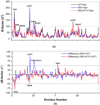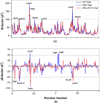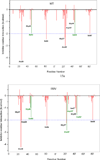Interaction of I50V mutant and I50L/A71V double mutant HIV-protease with inhibitor TMC114 (darunavir): molecular dynamics simulation and binding free energy studies
- PMID: 22239286
- PMCID: PMC3288396
- DOI: 10.1021/jp2074804
Interaction of I50V mutant and I50L/A71V double mutant HIV-protease with inhibitor TMC114 (darunavir): molecular dynamics simulation and binding free energy studies
Abstract
In the present work, the binding of inhibitor TMC114 (darunavir) to wild-type (WT), single (I50V) as well as double (I50L/A71V) mutant HIV-proteases (HIV-pr) was investigated with all-atom molecular dynamics (MD) simulations as well as molecular mechanic-Poisson-Boltzmann surface area (MM-PBSA) calculation. For both the apo and complexed HIV-pr, many intriguing effects due to double mutant, I50L/A71V, are observed. For example, the flap-flap distance and the distance from the active site to the flap residues in the apo I50L/A71V-HIV-pr are smaller than those of WT- and I50V-HIV-pr, probably making the active site smaller in volume and closer movement of flaps. For the complexed HIV-pr with TMC114, the double mutant I50L/A71V shows a less curling of the flap tips and less flexibility than WT and the single mutant I50V. As for the other previous studies, the present results also show that the single mutant I50V decreases the binding affinity of I50V-HIV-pr to TMC, resulting in a drug resistance; whereas the double mutant I50L/A71V increases the binding affinity, and as a result of the stronger binding, the I50L/A71V may be well adapted by the TMC114. The energy decomposition analysis suggests that the increase of the binding for the double mutant I50L/A71V-HIV-pr can be mainly attributed to the increase in electrostatic energy by -5.52 kacl/mol and van der Waals by -0.42 kcal/mol, which are canceled out in part by the increase of polar solvation energy of 1.99 kcal/mol. The I50L/A71V mutant directly increases the binding affinity by approximately -0.88 (Ile50 to Leu50) and -0.90 (Ile50' to Leu50') kcal/mol, accounting 45% for the total gain of the binding affinity. Besides the direct effects from the residues Leu50 and Leu50', the residue Gly49' increases the binding affinity of I50L/A71V-HIV-pr to the inhibitor by -0.74 kcal/mol, to which the electrostatic interaction of Leu50's backbone contributes by -1.23 kcal/mol. Another two residues Ile84 and Ile47' also increase the binding affinity by -0.22 and -0.29 kcal/mol, respectively, which can be mainly attributed to van der Waals terms (ΔT(vdw) = -0.21 and -0.39 kcal/mol).
Figures





















Similar articles
-
A contribution to the drug resistance mechanism of darunavir, amprenavir, indinavir, and saquinavir complexes with HIV-1 protease due to flap mutation I50V: a systematic MM-PBSA and thermodynamic integration study.J Chem Inf Model. 2013 Aug 26;53(8):2141-53. doi: 10.1021/ci4002102. Epub 2013 Jul 24. J Chem Inf Model. 2013. PMID: 23834142
-
Structural and thermodynamic basis of amprenavir/darunavir and atazanavir resistance in HIV-1 protease with mutations at residue 50.J Virol. 2013 Apr;87(8):4176-84. doi: 10.1128/JVI.03486-12. Epub 2013 Jan 30. J Virol. 2013. PMID: 23365446 Free PMC article.
-
Exploring the drug resistance of V32I and M46L mutant HIV-1 protease to inhibitor TMC114: flap dynamics and binding mechanism.J Mol Graph Model. 2015 Mar;56:60-73. doi: 10.1016/j.jmgm.2014.11.003. Epub 2014 Dec 5. J Mol Graph Model. 2015. PMID: 25562662 Free PMC article.
-
Resilience to resistance of HIV-1 protease inhibitors: profile of darunavir.AIDS Rev. 2008 Jul-Sep;10(3):131-42. AIDS Rev. 2008. PMID: 18820715 Free PMC article. Review.
-
Darunavir, a conceptually new HIV-1 protease inhibitor for the treatment of drug-resistant HIV.Bioorg Med Chem. 2007 Dec 15;15(24):7576-80. doi: 10.1016/j.bmc.2007.09.010. Epub 2007 Sep 14. Bioorg Med Chem. 2007. PMID: 17900913 Free PMC article. Review.
Cited by
-
Effects of drug-resistant mutations on the dynamic properties of HIV-1 protease and inhibition by Amprenavir and Darunavir.Sci Rep. 2015 May 27;5:10517. doi: 10.1038/srep10517. Sci Rep. 2015. PMID: 26012849 Free PMC article.
-
Structural Studies of a Rationally Selected Multi-Drug Resistant HIV-1 Protease Reveal Synergistic Effect of Distal Mutations on Flap Dynamics.PLoS One. 2016 Dec 16;11(12):e0168616. doi: 10.1371/journal.pone.0168616. eCollection 2016. PLoS One. 2016. PMID: 27992544 Free PMC article.
-
The structural, dynamic, and thermodynamic basis of darunavir resistance of a heavily mutated HIV-1 protease using molecular dynamics simulation.Front Mol Biosci. 2022 Aug 15;9:927373. doi: 10.3389/fmolb.2022.927373. eCollection 2022. Front Mol Biosci. 2022. PMID: 36046605 Free PMC article.
-
Investigation on the mechanism for the binding and drug resistance of wild type and mutations of G86 residue in HIV-1 protease complexed with Darunavir by molecular dynamic simulation and free energy calculation.J Mol Model. 2014 Feb;20(2):2122. doi: 10.1007/s00894-014-2122-y. Epub 2014 Feb 14. J Mol Model. 2014. PMID: 24526384
-
Structural Impacts of Drug-Resistance Mutations Appearing in HIV-2 Protease.Molecules. 2021 Jan 25;26(3):611. doi: 10.3390/molecules26030611. Molecules. 2021. PMID: 33503916 Free PMC article.
References
Publication types
MeSH terms
Substances
Grants and funding
LinkOut - more resources
Full Text Sources
Other Literature Sources
Research Materials

